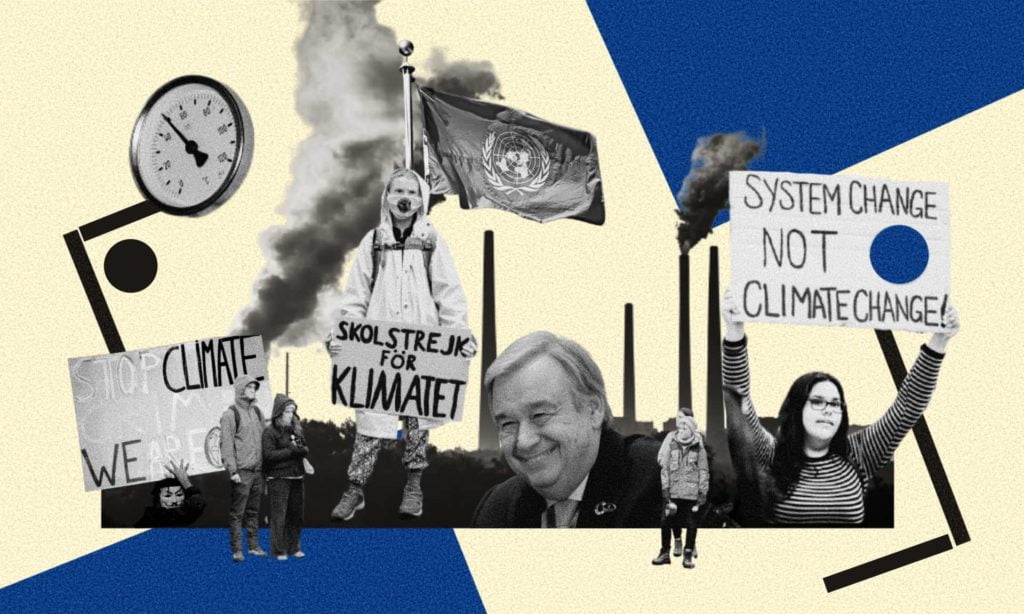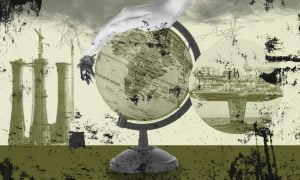Climate change is the world’s biggest collective enemy, which threatens to destroy the very planet that we all live on. Whether it be rising sea levels, global warming, record-breaking temperatures, melting ice caps or an overall shift in severity of natural disasters, we as humankind need to strategise together for immediate solutions.
Regarding the UN’s response, it can be commended for shining light upon the escalating emergency; with, for example, setting up the annual COP meetings since 1995 to assess progress in dealing with climate change. Also, at COP 21, the UN established the landmark 2016 Paris Agreement, which was signed by 196 parties worldwide and is based upon limiting a global temperature increase to below 2 degrees. Other exposure includes promoting sustainable lifestyle changes, working with climate activists, and dedicating an entire Sustainable Development Goal (SDG) to combating climate change.
Therefore at surface level it would seem that the UN has a defined strategy battling against climate change, however if you dive deeper the situation is worrying, as scientists, multiple studies and the UN itself believe global warming will increase by 3-5 degrees by the end of the century.
So, what has gone wrong?
This is what this article intends to explore, and it will attempt to answer this query by examining how the UN is progressing towards completing targets associated with their 13th SDG – which is dedicated to fighting climate change. Additionally, this article will analyse the Paris Agreement’s progress, propose expert-based solutions and answer some key questions:
- Has COVID-19 affected climate change?
- What is needed to solve the climate crisis?
- Is it time for a new approach?
The Targets
The UN has dedicated 5 Targets and 8 Indicators for SDG 13. Targets define the goals, and Indicators represent the metrics utilised to track progress.
The article will move onto evaluating the UN’s progress towards these targets by breaking them down.
Target Breakdown
Target 13.1: Strengthening resilience…
Target 13.1 is all about reinforcing countries’ resilience against natural disasters, mainly by implementing risk reduction strategies which will ideally reduce the deaths inflicted by natural disasters.
To track progress towards completing this target, the useful SDG tracker website is a good starting point. Although, the data provided is quite limited, with most graphs and tables ending in 2017 or 2018 you can still track progress and from this dataset the following conclusions can be made:
- The annual death rate from natural disasters per 100,000 people has decreased from 2015 to 2017, and further research shows that 2020 is the lowest year for natural disaster inflicted deaths.
- Natural disasters cause $390 billion of damage per year
- From 2015 to 2017, the amount of internally displaced people from natural disasters has both increased and decreased. With people who have either upper middle incomes, or reside in Latin America and Cuba being the worst inflicted, with an increase of 7 million people being displaced from 2015
- By 2018, 26 countries across the world still had not adopted the UN recommended Sendai Framework for Disaster Risk Reduction. Yet, many countries have and are performing well in the UN’s eyes.
- Disappointingly in 2018, very few local governments across the world have adopted disaster risk reduction strategies – albeit this could be down to countries situated in areas where natural disasters are not rife.
From these results it’s clear that the UN is succeeding in reducing natural disaster inflicted deaths and signing up countries to implement natural disaster risk reduction strategies. Yet, further research shows that many countries are failing to take the right steps to mitigate natural disaster effects and even the best plans for countries more subjected to disaster are questionable because of rife poverty. These trends show that the UN either needs to hold them to account for failing to meet protocol for lifesaving initiatives or provide more resources.
With scholars reporting that climate change exacerbates natural disasters immensely, this task needs to be carried out sooner rather than later. This correlation is common and can be seen clearly with the Australian wildfires, which gained worldwide attention in 2020, where scientists reported that climate change made those fires 30% more likely to occur.
Target 13.2: Integrating climate change measures…
This target is based upon countries integrating climate change measures into national policy and tracking the rate of CO2 emissions.
Data and research show that:
- In 2015, 197 countries had incorporated multilateral agreements.
- Ukraine, Turkey, Saudi Arabia, Russia, USA and China are the worst culprits when it comes to reducing greenhouse gas emissions. Whilst Monaco, The Gambia and Costa Rica are the best.
- Between 2015 and 2019 CO2 emissions have risen 1.23 billion tonnes and the peak hasn’t occurred yet.
- In 2020 CO2 emissions eased – mainly due to COVID-19 pandemic – however this is not expected to last.
The data above, to put it simply, is frightening, since the only success the world collectively has had in fighting climate change since the Paris Agreement and creation of the SDG in 2015 is due to a deadly pandemic halting normal day-to-day life. The data also suggests that despite many countries adopting climate change measures they are clearly not doing enough to reduce carbon emissions.
Target 13.3: Raising awareness…
The target 13.3 has one primary goal of raising awareness of the dangers of climate change around the world.
The SDG tracker provides no data on how to track the progress of this goal which raises plausible doubts as to whether the UN can achieve this target.
Further sources suggest that despite the importance of environmental literacy, in Europe only Italy has made it a compulsory subject.
Additionally, according to some scholars, education is rarely mentioned in discussions of major climate solution strategies.
It is quite evident that the UN needs to do more regarding this target and enforce education about climate change in school curriculums from a young age. Instances when children have been subjected to this learning are positive. A report by Stanford University concluded that 83% of pupils who had undergone environmental awareness classes from nursery to the end of secondary school had improved their environmental behaviour.
Target 13.A: Implementing agreed commitments…
The primary objective of this target is for member States to collectively contribute $100 billion annually to the UN from 2020 to support the Green Climate Fund (GCF) aimed to support low-income countries in climate mitigation and adaptation.
Data shows that the UN is nowhere near this target and in 2020 it only received a pledge of $10.4 billion – $89.6 billion from the intended target.
The lack of funding can be potentially excused due to the COVID-19 pandemic which has impacted economies worldwide immensely.
Yet, climate change will not slow down because of COVID-19, and it still requires greater contributions from UN member states if humankind is going to solve it.
Target 13.B: Supporting vulnerable and developing countries…
This target focuses on building support for planning and management in the least developed countries.
The criteria around tracking this target’s progress is vague and practically non-existent, which raises concerns regarding a lack of transparency from the UN.
Some studies suggest that vulnerable developing countries are leading the world on climate change action as they experience it daily. They are supported in this by the World Bank, which has recently devised a Climate Change Action initiative, which aims to deliver record levels of climate finance to developing countries from 2021-2025.
UN is failing to achieve the Paris Agreement and SDG 13
The breakdown of the targets above suggest that the UN is in fact failing to meet the core objectives of SDG 1, as well as falling short when it comes to pushing through the revolutionary Paris Agreement.
The failure can be exemplified in the following three statistics:
- Co2 emissions reached record levels in 2020 and they are continuing to rise.
- In 2020 the world’s global temperature reached record breaking levels.
- By the end of the century global warming shall have increased by 3-5 degrees.
Regarding COVID-19’s effect on the environment, as mentioned above, it actually helped ease climate change. This is mostly due to the stringent lockdowns imposed by countries worldwide which reduced aviation and travelling.
Therefore, unless another pandemic is coming our way before 2030 the UN needs to take responsibility for its failures and explore new approaches for solving climate change.
What did the UN do wrong?
Inserted below are the main criticisms for the UN’s limited success in achieving both SDG 13 and the Paris Agreement:
Failure of holding countries to account
For both the Paris Agreement and SDG 13, there is a lack of repercussions for countries that fail to achieve what they set out.
Without legal ramifications, countries may see their environmental pledges as meaningless and as something to put on the back burner.
This attitude would be catastrophic because of the devastating and irreversible damage it can do
Only 75 governments out of the ones that signed the Paris Agreement met the deadline to submit their climate plans in 2020.
The goals set out in climate plans would mean emissions would only fall by a measly 0.5%; a scenario condemned by Climate Chief Patricia Espinosa. China, Russia and the USA, who are three of the five permanent members of the UN Security Council, are the worst culprits in reducing CO2 emissions.
Failure of holding corporations to account
The UN is also failing to hold corporations to account for their environmental crimes:
- A 100 energy companies have been responsible for 71% of all industrial emissions since human-driven climate change was officially recognised
- Through lobbying and other practices, Exxon, an American multinational oil company, blocked U.S climate policies despite actively knowing about the damage of climate change.
- Corporations cause $2.2 trillion in environmental damages every year.
- Food production by corporations is responsible for one-quarter of the world’s greenhouse emissions.
- Soy and Beef farming has caused the Amazon rainforest to emit more CO2 than it absorbs.
The UN itself
The UNFCCC (United Nations Framework Convention on Climate Change) is failing and is in dire need of reform. Instead of reducing annual emissions of greenhouse gases it is allowing them to increase, and today they are 60% above 1994 levels. Moreover, the UN development programmes created to help fight environmental challenges, such as deforestation, have been indicted on corruption and fraud. Brice Bohmer of Transparency International stated that although people see ‘climate’ and ‘corruption’ as two distinct issues, there is, in fact, “a lot of overlap”.
The UN’s shortsighted growth models also exacerbate the situation. SDG 8, for instance, calls for a 7% annual GDP increase in developing countries, but uses old industrial growth models that kill our environment.
How to solve Climate Change
Despite the complexity and intricacy behind the damage that climate change does, the answers regarding how to combat it are relatively simple, such as reducing greenhouse gases or promoting sustainability. The actual process of carrying out the plan on a universal basis involves accountability, transparency and consensus – all characteristics the UN is not showing currently.
Expert based solutions include:
- Fossil fuels need to be replaced with cleaner and renewable energy like wind.
- Reducing meat and dairy consumption and promoting sustainable diets such as vegetarianism and veganism instead. This could reduce Global Farmland by 75% and still feed the world. Also, it would reduce global CO2 emissions by up to 8 billion tonnes per year.
- Forests and Indigenous people’s lands need to be protected and not given to Fossil Fuels industries.
- Corporations and countries must be held to account for their environmental crimes and penalties must be imposed to discourage further crimes.
- Enshrining clear universal climate change plans, so there can be no confusion or ambiguity, which could easily be exploited.
The simplicity of these solutions is damning to the UN and with the escalating climate change crisis it should be in humanity’s self-interest to look for another international order that enshrines humanity and the environment. This international order could be the ambitious and alternative United Nations called UN-aligned which proposes better and humanistic policy in combating climate change.
What can UN-aligned do better?
UN-aligned suggests a variety of expert-based solutions that would protect the world’s environment from harm and actively battle the escalating climate catastrophe. These tenets would appear seldom to UN environmental policy, which is superficial, ambiguous and inconsistent.
UN-aligned promotes the following environmental policy:
- Reducing carbon footprint
- Investment and research into clean energy
- Improved recycling methods
- Implementing legislation to protect the planet from exploitation
- Enshrining animal rights
- Promoting vegetarianism and veganism
- Subsidising cruelty-free products
If you believe in the UN-aligned cause and seek further information, check out Adrian Liberto’s book ‘Unravelling the United Nations’ or become a member of the cause at un-aligned.org.




















